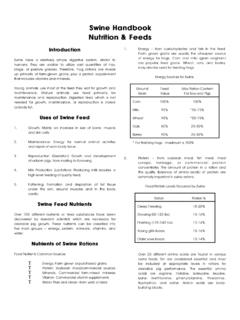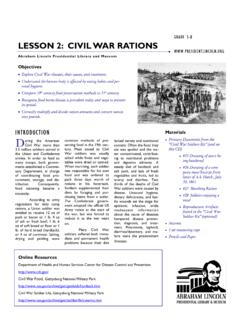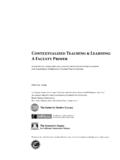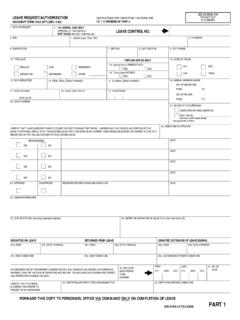Transcription of GRAIN RESERVES , DAILY RATIONS, AND THE SIZE …
1 GRAIN RESERVES , DAILY RATIONS, AND THE SIZE OF THE assyrian army : a quantitative STUDyl Frederick Mario Fales -Padova The State Archives of Assyria have left us abundant data of quantitative and statistical relevance: but one of the most vexing aspects of the study on Neo- assyrian history concerns the ultimately elusive quality of such data. Perusal of such rich statistical material such as the Nimrud Wine Lists2 or the letters to Esarhaddon on incoming shipments of horses3 suffices to pinpoint the problem: while we certainly are not short of attestations of quantities and amounts of all sorts, we mainly lack the standards of reference against which to set them, be they "general totals" or even just "partial totals" of sectorial significance. It is fine to be able to state that, according to known sources, a DAILY shipment to the court comprised an average of 107 horses and mules4; but how many equids in all were required -or were considered minimally sufficient -for an average military campaign?
2 And, as for population: it is fine for Assurnasirpal II to tell posterity that he invited 69,574 people to his famous banquets: but how is this total to be rated against that of the total population of Kalhu (city and province), or even against that of the whole country at the time? In brief, what might be I) I am grateful to Dr. Lanfranchi for extensively discussing the letters treated in the present article, and for his kind comments a!ld very apt suggestions. Dr. L. Milano, Rome, and Prof. C. Zaccagnini, Bologna, have given me kind and friendly advice on matters of rations in Mesopotamia, and for this I am very grateful to them. 2) Kinnier Wilson, The Nimrud Wine Lists, London 1972, passim (henceforth = NWL). 3) Cf. Fales, Assur II3 (1974), pp. 5-24; Postgate, TCAE, pp. 7-18. 4) Personal calculation based on Postgate, TCAE, table on pp.
3 8-9.. 5) Mosul stone slab ( Wiseman, Iraq 14 [1952]' pp. 24-44; most recent edition by Grayson, assyrian Rulers II, pp. 293-298). 24 FREDERICK MARIO FALES [SAAB IVIl said to be lacking as regards Assyria, is a perception of just how "great" this great empire was6. As a small contribution to an evaluation of the Neo- assyrian empire along quan-titative guidelines, I would here like to comment on three letters published in the SAA series. The texts are all from the age of Sargon II, but have no common archival origin, and they also deal with essentially different matters. What characterizes them in common, on the hand, is a concern with numbers -and these numbers may, I think, be made to reveal mutual links (or perhaps merely "interfaces") toward a quantitative picture of (1) the GRAIN RESERVES present within a specific territory, (2) the standard DAILY rations of GRAIN and oil, and (3) the size of the assyrian army .]
4 The results-I forewarn the reader-will represent nothing else than a starting lead onto a specific "track" that one hopes will be further beaten in the future. Text I (SAA V 251 == CT 53 47 + ABL 1290) This long letter (22+ 26' lines) is by an unkn-own writer, and shows a clear division in two parts, more or less corresponding to the faces of the tablet. On the Obverse, the subject is a progress report on the arrival of a part of the army in Kar-Assur7, led by magnates: the turttinu, the rab saqe, and a number of governors ~rom the western provinces (Na~ibina, Laqe, Si'imme, Tille, Guzana, Isana). Other military contingents and civilian personnel -including the royal entourage -are said to be expected shortly; and the general tone of the letters suggests that a preparation for a major campaign is being described here8.
5 6) For an attempt to evaluate the dimensions of the Neo- assyrian court, ct. S. Parpola, JSS 21 (1976), p. 166. For an attempt to calculate the numbers pertaining to deported populations, ct. B. Oded, Mass Deportations and Deportees in the Neo- assyrian Empire, Wiesbaden 1979, pp. 19 ff .. A recent overview on numerical matters in assyrian royal inscriptions is M. De Odorico, I numeri neUe iscrizioni reali assire, unpub. Diss. ad lauream, Univ. of Bologna, 1987-88. 7) This site -constructed by Tiglath-pileser III (ct. Brinkman, PHPKB, p. 230, and fn. 1447) -is on the south-eastern reaches of Assyria, certainly not too far from Gananate in the Hamrin (ct. Levine, Geographical Studies in the Neo- assyrian Zagros, Toronto and London 1974, XI, 25-26), as well as from Arrapha and Lahiru (d. Parpola, NAT, ). In fact, Lahiru could have been the surrounding province, if we are to judge from Rev.
6 14' of the present letter (ct. footnote 11, below). 8) Lanfranchi suggests the possibility that this campaign could have been that of 713, in which the [UJ]GAL ME5 went to KURIl_Ii_pa, according to the Eponym Chronicle Cb4 (Cf. A .. Ungnad, RIA II [1938], Eponymen, p. 433). Both the presence of the "magnates" and a localization in or around Lahiru would seem to point in this direction, although no actual evidence can be summoned on this point. 1990] GRAIN RESERVES , DAILY RATIONS, AND THE SIZE OF THE assyrian army 25 On the reverse, the writer mentions a royal order, viz. (4'-5'): SE] tab-ku / sa IT! UDMES-te [sa U ]Ru-ka se-bi-la-a-ni, "Send me (the data on) the stored GRAIN of your city by month and day.,,9. To this request -only seemingly unconnected to the arrange-ments for war -the writer gives a very detailed answer, in the form of a list of quantities of , "barley", counted ina bat-ta-ta-a-a (1.
7 7'), "item by item", and measured by emiirus and sutus. The list is split up into four distinct items. The first two items concern types of GRAIN (and their respective recipients): thus we find on one hand (a) SE ki-su-tu sa a-~ap-pilO, "fodder for pack -animals" , and on the other (b) SE tab-ku sa ERIMMES, "stored GRAIN for the men,,}l. The data stemming from these two items is then further split in two brackets; but the reason for this second subdivision is slightly obscure, due to breaks in the tablet. However, on the basis of the extant signs, it may be plausibly suggested that it concerned the different geographical contexts (as well as the political institutions) to which the GRAIN was attached, on one hand (1) the royal granaries in the town Kar-Assur, and on the other (2) the stocks of the magnates, from their respective towns which had at present been brought to the province of Lahiru 12.
8 Up to this point, the list has been concerned exclusively with DAILY rations. After this, we find three different general totals. Two of such totals (la+2a=a; 1b+2b=b) are by type, and concern DAILY quantities again, and then their monthly equivalents (A, B, obtained by multiplying the DAILY total by 30); while the third total represents the final sum, the entire amount of GRAIN in monthly storage (a+b=c). To clarify the above, the numerical aspects in the writer's report may be presented in chart form: 9) My rendering is intentionally slightly more literal than the one by Parpola-Lanfranchi: "Send me (data on) the stored GRAIN (consumed) by your [ci]ty in a calendar month". 10) Cf. line 6' for this fuller formulation; elsewhere the "pack-animals" are omitted. 11) This twofold division is paralleled with a slight variant in SAA 1,172 (= NL 88 = TCAE, pp.
9 381-383), where a provincial administrator of Sargon lists the amounts of provisions levied in his territory, amounting to 80 homers of fodder, and 738 homers of bread (sic: the 918 homers total in the letter is wrong, but ct. TCAE, p. 382 [!?]). In any case, the GRAIN for both animals and men is said in another letter (NL 71 = Iraq 27 [1965], p. 18, 13) to come from the te-lit ad-ri, "the produce ofthe threshing-floor": cf. Postgate, TCAE, p. 397. 12) Justification for this view is the following: (a) the royal request was for the amount of GRAIN s1a u]Ru-ka, as seen above, whereas the writer sees it fit to reply on all the GRAIN "item by item"; (b) in line 11' , where the first total would have been, the last part reads x L]U, which perhaps could be made out as L]UG[AL; (c) the second total (lines 13'-14') reads sa [ x x x ] sf!
10 URuME5-su-nu / ina NAM URU La-h[ ;ri,.x x x x ] -where the initial break could well have held the signs LUGAL MES, by analogy with line 20'. Finally, the signs after the name of the province have represented a verbal form ("brought", "carried with them" [?], etc.). 26 DAILY rations: (la) (1b) 1( =la+b) (2a) (2b) 2(=2a+b) Totals: (a=la+2a) (A=ax30) (b=1b+2b) (B=bx30) FREDERICK MARIO FALES [SAAB IV/l 470 emtirus emiirus fodder for pack -animals stored GRAIN for the men 1, emtirus DAILY in [the r]oy[al granaries(?)] .. 108 emtirus emtirus fodder stored GRAIN for the men emtirus DAILY , of [the magnates], and of their cities, (now presen t) in the province of Lahiru. (470+108)= (578x30)= ( + )= (705x30)= 578 emtirus of fodder, DAILY ; 17,340 emtirus of barley per month; 1' 705 emtirus of stored GRAIN for the men, DAILY ; 21,150 emtirus of barley per month.]








